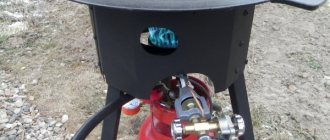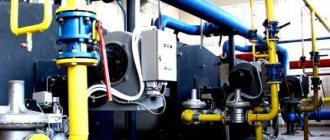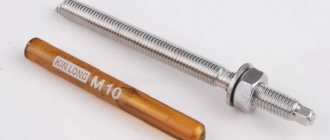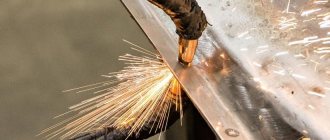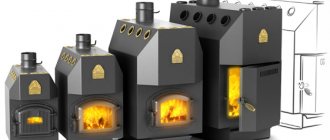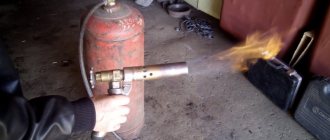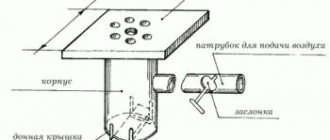SHARE ON SOCIAL NETWORKS
FacebookTwitterOkGoogle+PinterestVk
The gas burner for roofing work is designed to melt the bitumen coating and waterproof the roof during repair work. The tool is also used for drying concrete and brick, heating metal and plastic when bending. To operate the device, a cylinder with working gas is required. Features of the work, choice of tools and recommendations for creating a structure with your own hands - all this information is contained in the article.
A torch for roofing work is usually a torch with a hose and a fuel cylinder
Gas burner for roofing work: what is it?
Very often, during roofing installation and repair work, it is necessary to heat or dry the material, for example, when laying a waterproofing layer, to create a soft roof or to melt bitumen mastic. A roofing gas burner will help to complete these tasks. Using this device, you can perform several types of operations, namely:
- drying surfaces and materials;
The flame is controlled using regulators installed on the device
- cutting or soldering metal parts;
- burning and removing the old paint layer;
- sealing small cracks;
- melting bitumen-based mastic;
- heating sheets of material before laying;
- strengthening of seams and joints;
- other work that requires the use of high temperature.
A roofing torch is usually a torch with a hose and a fuel container. This design is very convenient, reliable and mobile. The volume of the gas cylinder can be different, the hose with the torch has a standard appearance. The flame is controlled using regulators installed on the device.
This is interesting! A roofing gas burner is a specialized gas-air type unit that is used for installation and dismantling of soft roofing coverings, as well as for drying various building structures.
A gas burner is needed to perform those jobs that require the use of high temperature
Scope of application after modification
Gas burners are used in households and agriculture, during construction and repair work, when repairing vehicles and equipment,
In addition to the listed areas, gas appliances are used for the following purposes:
- installation of heat shrink tubes;
- melting the solder before soldering;
- heating metal water pipes;
- heating bitumen for roof repair.
In addition to the above, the device is used for removing paintwork by firing the surface, for welding materials whose melting point is about 1000 C. With its help, you can cook or heat food or boil water for tea right on the construction site.
Propane burners: professional and budget models
Experienced foremen usually buy expensive professional models, which are reliable and safe to use. But for a self-taught craftsman, simple and small designs are quite suitable for home use. Let us consider further how the choice of this or that equipment will affect the quality of work.
A simple burner is not intended for industrial work, where it must be used almost every day. In this case, you will need a reliable model that can withstand uninterrupted operation and guarantee absolute safety. At the same time, a cheap and simple design in the hands of a skilled and careful craftsman can last for several decades. Especially if you have to use it only once a season.
Regardless of which product is chosen: an expensive and professional burner with a cylinder or a cheap household design, before each use it is necessary to check the tightness of the product, especially the connection points, the fuel supply hose and the mouthpiece for clogging. If you miss even a minor defect, you can provoke serious problems.
Propane burner is very convenient, reliable and mobile design
Helpful advice! Even for home use, you should not buy the cheapest burner. Most likely, this model will have a weak gearbox, which means that the tool’s performance will be on par with the power of a blowtorch. Working with such a device will be very slow.
Design features and operating principle
Burners vary in design - from basic devices with a nozzle to more complex mechanisms equipped with an air supply device and piezo ignition.
Let's consider the design of a torch designed for welding metal.
The design with an injector and check valve increases work productivity and reduces fuel consumption.
Almost all portable household appliances belong to the so-called injection burners, when air is naturally sucked into the burner to support the flame.
Inside, in a special chamber, fuel is mixed with air, as a result of which the fuel ignites after a spark is given.
From the mixing chamber, the mixture of gases enters the nozzle-nozzle, where it is distributed through the channels. At the end of the structure, at the point where the torch is formed, there are fire holes - the ends of the channels.
Options for nozzles by structure: ring, slot, tubular.
Gas burner for roofing on a cylinder or can
At first glance, it may seem that pulling a gas cylinder onto the roof is the most dangerous idea, especially since there are a lot of hand-held burners on sale. In fact, it is the canister burners that often cause burns, fires and injuries. This is due to the sale of fake and cheap Chinese products. The safety of burners with a large cylinder lies in the fact that the container itself is located far from the flame during operation.
When purchasing, do not pay attention to too cheap models. The main problem with such structures is that the technical data sheet indicates an operating pressure of 0.05-0.08 MPa, which during operation turns out to be several times higher. The gearbox installed on the device is absolutely not designed for heavy loads, so a closed valve may simply not withstand such stress.
Gas burners on a can have a combustion temperature of about 700-1000 °C
Gas burner for a cylinder: characteristics of the device
The design of the gas burner includes a handle, a gas supply tube and a metal cup attached to its end. A hose is connected to the handle, through which the working gas is supplied from the gas cylinder. The handle can be made of plastic or wood.
The gas burner bowl is designed in such a way that the flame is protected from the wind during operation. Glasses of different models have different devices, but their operating principle is the same. It is also possible to adjust the flame length. Modern models are equipped with a special gearbox, on which, using a valve, you can control the pressure and fuel consumption.
By pressing the handle lever, the valve opens and gas enters the glass through a tube and hose. The flammable mixture of working gas and air is ignited with a lighter or with ordinary matches. The combustion temperature of a gas burner is very high and can reach from 500 to 1500 °C.
Absolutely all models of gas roofing burners are equipped with an atmospheric air supply system. There is also a device for adjusting operating modes: operating mode and standby mode. For the manufacture of devices, only high-quality and very durable materials are used, since the burner heats up to the highest temperatures. Typically, the weight of the structure is small and varies from 1 to 1.5 kg, so the tool is easy to hold in your hands.
By pressing the handle lever, the valve opens and gas enters the glass through a tube and hose
Modern roof burners differ from each other in the principle of adding oxygen to the fuel. Older models require connection to an oxygen cylinder, which is not entirely convenient. Modern designs take air from the atmosphere. Typically, propane is used as the burner gas, but there are samples that run on pure methane.
It is important! The length of the handle for holding the gas burner should measure about one meter, but no more. In this case, it is necessary that it be equipped with a special holder made of heat-resistant plastic or high quality wood, thanks to which the master’s hands are protected from burns.
Gas burners on a can: description of the tool
The burner in the form of a nozzle on a gas cylinder with a collet connection is used only in strict compliance with fire safety rules, as well as in places where heavy construction equipment is not working and the risk of damaging the burner with the cylinder is minimal.
The simplest models have a combustion temperature of about 700-1000 °C. Oxygen enters the burner from the air, so it is always in short supply. In tools that have a higher cost, the flame temperature reaches 1200 °C, and they have a specific shape of air supply holes that help increase the amount of oxygen in the burner.
Gas burners on a can are equipped with a flexible or rotating tube and a valve for adjusting the flame
Manual gas burners of the ejector type have an even higher flame temperature. In these structures, air flows to the fire due to rarefaction. Thanks to this, the flame reaches a temperature of 1500-1600 °C. It is also possible to regulate the flame length relatively smoothly using a tap. This model is not designed for delicate work, but is great for heating large areas.
All types of gas burners are equipped with a flexible or rotary tube, piezo ignition and a highly sensitive valve for adjusting the flame. Currently, there is a large selection of tools according to their power and fuel consumption.
Gas burner for soldering: features of models
Ejector lamps for soldering have a special design and purpose. Most often, these tools are used by craftsmen for processing non-ferrous metals. The high temperature and adjustable flame of the torch make it ideal for soldering and hardening of metals or any other heat treatment that requires high temperature accuracy and a clearly defined flame cone.
Gas torches are most often used for processing non-ferrous metals
The sizes of canister burners and nozzles can vary significantly, which allows them to be used in various fields. Very miniature models are used for soldering jewelry and thin metal. Although the tool is not equipped with a device for supplying oxygen, it does an excellent job of filigree work.
Medium type devices have a cone thickness of 0.3 to 0.9 cm and are optimally suited for soldering copper and aluminum tubes. Due to their high power, large burners should be used in artistic forging or metal stamping.
For ejector burners, the use of the concept of an unstable flame is not entirely correct. Since, although flashes are possible from time to time, this has little effect on the temperature in the core of the instrument’s flame.
Choosing gas
You can only make a gas burner using propane, butane or a propane-butane mixture with your own hands, i.e. on gaseous saturated hydrocarbons and atmospheric air. When using 100% isobutane (see below), it is possible to achieve flame temperatures of up to 2000 degrees.
Acetylene allows you to achieve a flame temperature of up to 3000 degrees, but due to its danger, the high cost of calcium carbide and the need for pure oxygen as an oxidizing agent, it has practically fallen out of use in welding work. It is possible to obtain pure hydrogen at home; a hydrogen flame from a supercharged burner (see below) gives temperatures up to 2500 degrees. But the raw materials for producing hydrogen are expensive and unsafe (one of the components is a strong acid), but the main thing is that hydrogen cannot be smelled or tasted, there is no point in adding a mercaptan fragrance to it, because Hydrogen spreads an order of magnitude faster, and its admixture with air of only 4% already produces an explosive explosive gas, and its ignition can occur simply in the light.
Methane is not used in household gas burners for similar reasons; in addition, it is highly poisonous. As for flammable liquid vapors, pyrolysis gases and biogas, when burned in gas burners they produce a not very clean flame with a temperature below 1100 degrees. Flammable liquids of medium and below average volatility (from gasoline to fuel oil) are burned in special liquid burners, for example, in burners for diesel fuel; alcohols are used in low-power flame devices, and ethers do not burn at all - they have low energy, but are very dangerous.
Gas burner for roofing: laying material
Very often, roofing felt is used in roofing work, and it is impossible to create high-quality waterproofing from this material without a gas burner. You will also need a tool to cover the roof with welded types of modern materials.
When laying roofing felt on the roof, you can’t do without a hay burner.
The entire process of working with the burner can be divided into several stages:
- First, the preparation of the base for laying the coating is organized; for this it is necessary to clear it of debris. If necessary, you can level the surface using a screed.
- The entire surface is covered with rolled material so that adjacent sheets form an overlap 8.5-9 cm wide.
- Having leveled the material and completed the markings, the rolls are rolled back and secured at the base of the roof using a torch. To do this, the lower part of the roll and the base of the roof are heated with a flame, after which the roll of material is slowly unrolled and pressed against the base.
- To prevent the appearance of wrinkles and air bubbles, it is necessary to walk over the attached canvas with a hand roller.
- At the final stage, you should also use a burner, with which the seams of the material are heated. After this, they also need to be compacted with a hand roller.
Before using the roof burner, you need to familiarize yourself with several important points:
- Do not use the device at a temperature of 15 degrees below zero;
- if roofing work is carried out at low temperatures, then it is allowed to use a liquid fuel burner;
Before using the roof burner, you need to familiarize yourself with several important rules
- the use of a gas burner with high technical characteristics for roofing makes it possible to lay about 500-600 m of roofing material per day;
- Since the process takes place in the open air, the burner must operate smoothly and have reliable protection from being blown out by the wind.
Related article:
Petroleum bitumens for construction and roofing (GOST)
Bituminous material provides waterproofing of complex structures where other materials cannot be used.
How to start a car in severe frost and not burn the car
When the thermometer mark exceeds minus 30, starting a car in cold weather becomes very difficult. And each such launch reduces the life of the car several times faster, unlike a summer launch.
VashGorod.ru has made a selection for motorists who decide to start their iron horse in 40-degree frost.
When warming up a car, many people use various “folk” methods: pouring hot water over the engine, warming up the car at a car wash, heating the engine with a gas burner flame, construction or household hair dryers and other heating devices. Let's look at each method in more detail.
Battery resuscitation
When the air temperature is very low in winter, the battery in the car freezes first. If you come to the parking lot in the morning and find that the car does not want to work, try removing it and taking it to a warming room. Or you can ask someone to “light” you, but for this you must have special wires, popularly called “crocodiles”.
Hot water for the engine
If the reason is not the battery, then craftsmen advise pouring boiling water from a kettle over the intake manifold, this will certainly increase the temperature of the air-fuel mixture, but there is a risk of flooding the wiring connectors with water, so you need to act very carefully, you can even cover the manifold with a rag and little by little pour water on her.
With a twinkle
It is not recommended for beginners to warm up a car using a gas burner due to the great danger of this method. But if you decide on this method, then you will need a metal pipe with a diameter of 30 mm and a length of about 1.5 meters. One edge of the pipe (100 mm) must be bent at a right angle. Place the bent edge on the engine and apply a blowtorch to the other end of the pipe.
However, you should carefully warm up the car using this method and before the procedure, check whether there are any oil or gasoline leaks on the surface of the pan
Hairdryers, stoves, guns
Anything that heats up can also be useful. Some people warm up the engine using a heat gun (from the crankcase side) or a heat gun. With this method, the torque converter of the automatic transmission also warms up (automatic transmissions are more sensitive to frost). An electric hotplate, which is placed under the crankcase, can also be useful.
The “disadvantage” of these methods is that to operate both the hairdryer and the stove, you will need a 220 V electrical outlet. Although you can purchase a heat gun that runs on gasoline.
Candles are flooded
Flooded spark plugs are the most common reason why a car won't start. You don't need much effort to fill the spark plugs - just try to start the engine a couple of times to no avail. As a result, gasoline continues to flow into the combustion chamber, flooding the spark plugs.
What to do if the candles are flooded?
There are two ways: for the lazy and for those who are impatient.
If your car does not start, and you do not want to unscrew all the spark plugs, turn off the ignition and just wait a little, sit in the car, pressing the gas pedal. Through an open throttle valve, a pair of cylinders will be ventilated, and there is some chance that the gasoline in them will evaporate and the spark plugs will dry out. After 2-3 minutes, try to start the engine.
When using the second method, you need to unscrew all the spark plugs and take them to a warm room. After thoroughly drying the spark plugs, it is advisable to heat them (or “calcinate” them, as experienced car owners say). The easiest way to do this is to place them on the stove. When the candles heat up to the point that they cannot be held with your hands, transfer them from the stove to a previously prepared cloth and quickly bring them to the car. The hotter the candles are at the moment of twisting, the greater the chance that everything will end successfully.
Warm box
If you have tried everything possible and have not achieved a positive result, then you should call a tow truck and send your vehicle to a heated parking lot.
But the best way to avoid freezing is to keep your car in the garage or constantly warmed up.
Attention! When heating, you should not neglect the advice from the Ministry of Emergency Situations, so as not to be left without a car. Do not charge batteries directly on vehicles
Do not charge batteries directly on vehicles.
Do not warm up a frozen engine with open fire (torches, blowtorches) and do not use open fire sources for lighting.
Gas burner: price and characteristics of some popular models
Gas-air burners for roofing are the safest tools. They are easy to use, lightweight, and capable of creating a flame of sufficiently high power. Modern manufacturers offer models that operate without oxygen:
- GG-2 – propane burner for the roof. This is the best option for craftsmen who perform repair work themselves. It has an acceptable cost;
- GG-2U is a device similar to the previous version, but this model is characterized by a shortened version of the gas supply hose for the gas burner. This device is ideal for performing work in hard-to-reach areas of the roof, as well as for gluing joints;
Before purchasing a burner, it is important to read the specifications of the model and check the quality certificates
- GG-2S is a model that belongs to professional tools and runs on propane. The main advantage of the device is that the device can be used even in strong winds. The device is equipped with two valves and consists of two housings, making it easier to control the operating modes of the device;
- GGS1-1.7 is a universal design, which, despite its small size and weight, is characterized by a high degree of performance. The device can only be used on flat horizontal areas;
- GGK-1 - this burner is heavier than previous designs and is equipped with a very durable glass. This model is suitable for burning old paint, wooden surfaces, as well as for performing waterproofing work. Fuel is supplied using a special lever.
- GGS1-1.0 is used for small works of insignificant volumes. Optimally used on roofs with a large angle of inclination;
- GGS1-0.5 is used for minor repair work. The model is characterized by low fuel consumption;
- GGS4-1.0 consists of four bells, thanks to which the entire roll is heated simultaneously. The use of this option allows you to increase labor productivity and save fuel;
Gas-air burners for roofing are considered the safest tool
- GV-3 is a propane torch designed for welding and even manual soldering of metal. The diameter of the glass is 5 cm;
- GV-111R is used for melting bituminous materials and firing a layer of paint.
- GV-550 and GV-900 are very easy-to-use designs that differ from each other only in the maximum flame length. The first model is more suitable for performing tasks at the junction points of the roof, and the second device allows you to work while standing at full height, since the length of the torch reaches 90 cm;
- GV 500 is used to perform surfacing work during laying of roofing materials. This model melts bitumen with ease. The flame temperature of the GV 500 gas burner is 300 °C;
- GV-850 is a burner that has a special valve, thanks to which you can precisely regulate the amount of technical gas supplied from the cylinder. There is also a lever installed here, with which the master adjusts the length of the torch. This gas burner does not operate on pure propane, but on a mixture that contains technical oxygen. The price of a gas burner for roofing GV-850 is 1700-2200 rubles.
As you can see, the choice of gas burners is very wide, and where to buy a burner: in a store or on the website depends on the wishes of customers. The main thing is to read the specifications of the model and check the quality certificates for the product.
Helpful advice! GV class models are suitable for heating non-ferrous and ferrous metals, melting bituminous materials in rolls when performing waterproofing and roofing work, as well as in cases where the use of only propane is required.
Gas burners are easy to use, lightweight, and capable of creating a flame of sufficiently high power.
Tips for choosing the best burner
People buy compact hand burners with pleasure, as they have many advantages over liquid fuel, more “serious” devices. They light quickly, hardly get dirty, and require a minimum of care.
Criterion #1 – scope of use of the device
First of all, you should determine exactly what the gas appliance will be used for, since burners for soldering and for heating food are radically different in both design and parameters.
Construction tools often resemble a gun in shape. When working, it is convenient to hold them with one hand, and with the other at this time you can support the part or bring solder.
Criterion #2 – technical characteristics of the model
Characteristics such as weight and size are important if the burner has to be taken on hikes or often used at home. A heavy tool causes rapid fatigue, while a light one is much more comfortable to work with.
We pay attention to such characteristics as:
- flame temperature – from 480 to 2500°C;
- heating temperature – from 550 to 2500°C;
- power – 0.5-3 kW;
- the ability to connect cans with different fuels;
- method of connecting the cartridge to the burner;
- flame type, torch shape;
- fuel consumption – from 60 to 1000 g/h;
- weight – from 50 grams to 1.7 kg.
If you are purchasing a torch specifically for soldering copper pipes, then a low-temperature model will do.
To cut or weld steel parts, you will need a more powerful machine, usually called a torch or welding torch.
How to use a gas burner: safety rules
The operation of gas burners requires strict adherence to safety rules:
- Work with burners is carried out in special clothing and shoes with non-slip soles. You will also need a belt and walking bridges.
- Before using the tool, it is necessary to conduct an external inspection and ensure that the burner, cylinders and connecting hoses are in full working order.
- During use of the device, only one gas cylinder may be present at the work site.
- Do not stand in front of the nozzle while igniting the gas in the burner. The direction of the metal cup must be such that the fire cannot touch anyone nearby, the gas cylinder and the connecting hoses.
- If you use weldable materials, you must ensure that they do not overheat and do not catch fire. It is necessary to ensure that only the lower part is heated; the material should not be allowed to soften completely.
- The burner can only be lit with matches or a lighter.
- While working with the device, the master is prohibited from going beyond the boundaries of the workspace, as well as going down or up the scaffolding.
Extinguishing the tool occurs in two stages: first, the gas supply is shut off, and then the locking lever is released. Even after a short break in operation, the device should be extinguished. If there is a significant break, then the gas supply must be shut off at the cylinder itself.
Before using the gas-air burner, it is necessary to conduct an external inspection and ensure that it is in full working order.
Helpful advice! If the mouthpieces or connecting hoses are clogged, the device cannot be used, as kickback and popping noises may occur. If backlash occurs or the equipment overheats, you should immediately stop working and turn off the fuel supply to the cylinder. You can cool the instrument by immersing it in a container of water.
Mini
A very tiny gas burner can be made from a fitting for inflating basketballs, a syringe needle and a couple of droppers, or as they are called medical “systems” for drip administration of drugs. The homemade product can even work from a lighter refill can.
Adjusting roller clamps will act as valves.
True, we will need a forced air supply for this device; the nozzle diameter is too small for injection of atmospheric air. For this purpose, you can use the compressor of an aquarium or an old refrigerator.
Carefully grind off the tip of the syringe needle and fitting. After this, bend the syringe needle slightly and insert it into the side hole of the fitting, so that the end comes out slightly from the cut tip.
We wrap the needle insertion site with copper wire and solder it well with acid.
The burner is ready. All that remains is to connect gas and air to it.
Types of burners
All devices can be classified according to two parameters: operating technology and scope of application.
Based on the principle of operation, the following types of devices can be distinguished:
- diffusion, in which the process of mixing gas and oxygen is carried out during combustion;
- injection, where even before the gas enters the combustion chamber, it is enriched with oxygen;
- atmospheric, which, according to the principle of operation, resemble injection ones, but oxygen is supplied to a lesser extent;
- recuperative, where a special device - a recuperator - heats up the gas before mixing it with air;
- regenerative - similar to recuperative, but heating to the required degree is carried out by another unit - a regenerator, which first heats the gas and oxygen, and only then supplies it to the combustion chamber;
- inflatable, where air is forced into the combustion chamber using a fan;
- with pre-full mixing, where oxygen is added near the outlet;
- with incomplete premixing.
Devices are also classified by purpose:
- Household appliances characterized by low power. Most often we are talking about atmospheric devices, since their operation is associated with the least number of problems.
- Industrial equipment used in boiler rooms, factories and for heating a large number of residential units. The most common are injection, fan and diffuse devices.
